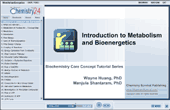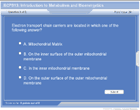Introduction to Metabolism and Bioenergetics
| Topic Review on "Title": |
Introduction
Living organisms are not at equilibrium. They require a continuous influx of free energy to maintain order in a universe where there is maximum disorder. Metabolism is the overall process through which free energy is acquired and utilized by living systems to carry out their various functions. By coupling the exergonic (energy releasing) reactions of nutrient oxidation and endergonic (energy consuming) reactions, they maintain the living state. Metabolism is the overall process through which free energy is acquired and utilized by living systems to carry out their various functions. Free energy is the most useful thermodynamic concept in biochemistry. A reaction can occur spontaneously only if ΔG, the change in free energy is negative. The reactions are coupled by the shared chemical intermediate. Energy is extracted from foodstuffs by three different stages.
In the first stage, large molecules of food are broken down into smaller units. No useful energy is liberated.
In the second stage, small molecules are degraded to a few simple units of metabolic importance like acetyl CoA. Some amount of ATP is generated here.
In the third stage, final common pathways in the oxidation of fuel molecules are citric acid cycle and oxidative phosphorylation. More than 90% ATP generation from degradation of food stuffs takes place in the third stage.
Universal carrier molecules
Processes involving the transfer of electrons are of immense biochemical significance. Oxidation-reduction reactions resemble other types of chemical reactions in that they involve group transfer. In Redox reactions, the groups transferred are electrons which are passed from an electron donor to an electron acceptor. NADPH is the major electron donor in reductive biosynthesis. NADH and FADH2 is the major electron carrier in the oxidation of fuel molecules. Coenzyme A is the acyl group carrier which is an important molecule in metabolism.
Bioenergetics of phosphate compounds
ATP is the universal currency of free energy in biological systems. It is an energy rich molecule because its triphosphate unit contains two phospho anhydride bonds. ATP on hydrolysis liberates a large amount of energy. Creatine phosphate is a reservoir of high potential phosphoryl groups in the muscle which can readily transfer its phosphoryl group to ATP.
Regulation of metabolic processes
Metabolism is regulated by controlling the amount of particular enzymes, catalytic activities and the accessibility of substrates. Many reactions in metabolism are controlled by the energy status of the cell. Index of energy status is the energy charge. An alternative index of the energy status is the phosphorylation potential. It depends on the concentration of inorganic phosphate and is directly related to the free energy available from ATP.
|
| Rapid Study Kit for "Title": |
| Flash Movie |
Flash Game |
Flash Card |
| Core Concept Tutorial |
Problem Solving Drill |
Review Cheat Sheet |
 |
 |
 |
|
| "Title" Tutorial Summary : |
Metabolism is the overall process through which free energy is acquired and utilized by living systems to carry out their various functions. Free energy is the most useful thermodynamic concept in biochemistry. A reaction can occur spontaneously only if ΔG, the change in free energy is negative. The reactions are coupled by the shared chemical intermediate. Energy is extracted from foodstuffs by three different stages. Processes involving the transfer of electrons are of immense biochemical significance. NADPH is the major electron donor in reductive biosynthesis. NADH and FADH2 are the major electron carriers in the oxidation (break down) of fuel molecules. ATP is the universal currency of free energy in biological systems. Creatine phosphate is the reservoir of high potential phosphoryl groups in the muscle.
|
| Tutorial Features: |
- Concept map to depict the metabolism of foodstuffs.
- Basic concepts are thoroughly discussed with definitions, examples and animations.
- Energy sources of anabolism discussed with animation.
- Diagrammatic representation of electron carrier NAD.
- Carrier molecules and groups carried in activated form are listed.
- Structure of ATP and ATP cycle is explained schematically.
- List of high energy compounds and free energy.
|
| "Title" Topic List: |
Metabolism
- Introduction
- Free energy
- Laws of Thermodynamics
- Coupling of reactions
Universal Carrier Molecules
- Oxidation- reduction reactions
- NADPH
- NADH
- FADH2
- Coenzyme A
Bioenergetics of Phosphate compounds
- Role of ATP
- Universal currency of free energy
- Creatine phosphate
Regulation of Metabolic Processes
- Regulation of Metabolism
- Energy charge
- Phosphorylation potential
|
See all 24 lessons in college chemistry, including concept tutorials, problem drills and cheat sheets:
Teach Yourself Biochemistry Visually in 24 Hours |



